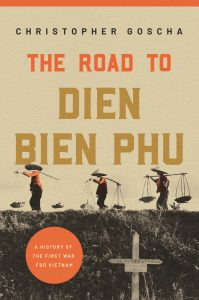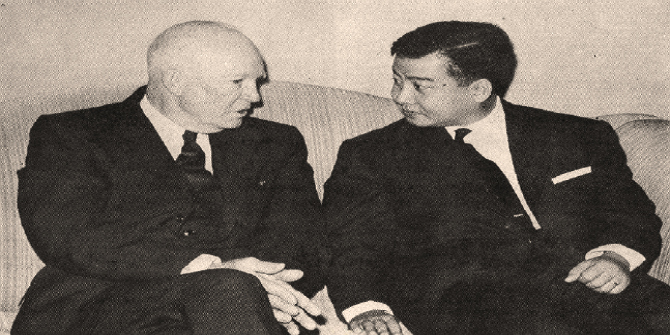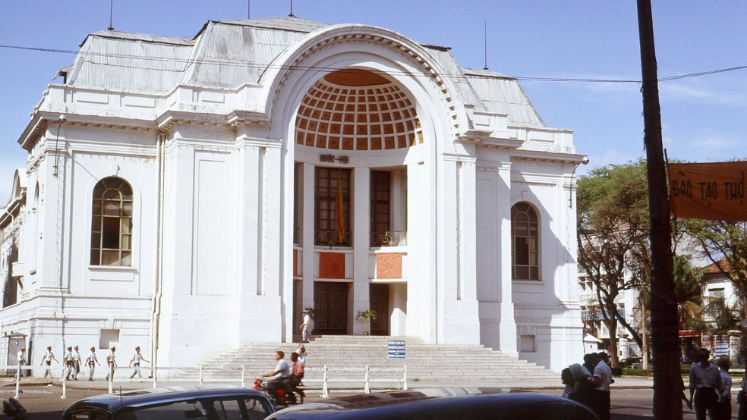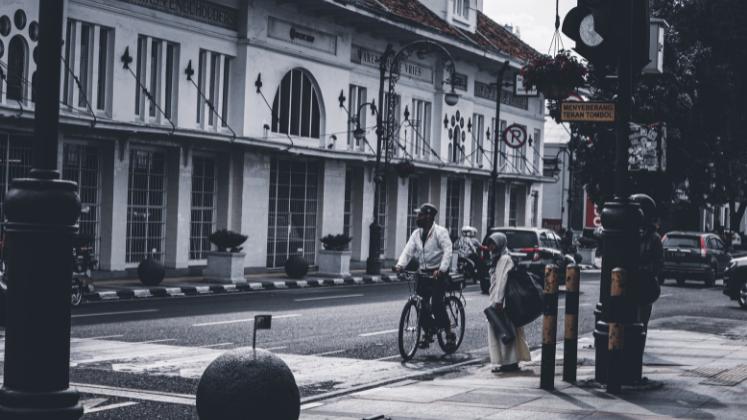In The Road to Dien Bien Phu: A History of the First War for Vietnam, Christopher Goscha offers a comprehensive account of the First Indochina War and the 1954 battle in which Vietnam defeated the French colonial power. This masterful account stands out for its focus on particular individuals, humanising the war and the high price paid by the Vietnamese people, writes Seb Rumsby.
This book review is published by the LSE Southeast Asia blog and LSE Review of Books blog as part of a collaborative series focusing on timely and important social science books from and about Southeast Asia.
The Road to Dien Bien Phu: A History of the First War for Vietnam. Christopher Goscha. Princeton University Press. 2022.
 The Road to Dien Bien Phu is an extensive and comprehensive account of the lesser-known First Indochina War – the one to oust the French colonial regime from 1945 to 1954, before the Americans took their place. Although he does not explicitly acknowledge it, author Christopher Goscha has apparently borrowed the book name from former army general Võ Nguyên Giáp, who plays a key role in the story and whose Vietnamese-language memoirs were also entitled Đường tới Điện Biên Phủ. Nevertheless, the key protagonist is Vietnamese national personality cult hero Hồ Chí Minh, whose conversation with an American journalist in 1945 is used by Goscha to problematise conventional understandings of the war and articulate his core argument.
The Road to Dien Bien Phu is an extensive and comprehensive account of the lesser-known First Indochina War – the one to oust the French colonial regime from 1945 to 1954, before the Americans took their place. Although he does not explicitly acknowledge it, author Christopher Goscha has apparently borrowed the book name from former army general Võ Nguyên Giáp, who plays a key role in the story and whose Vietnamese-language memoirs were also entitled Đường tới Điện Biên Phủ. Nevertheless, the key protagonist is Vietnamese national personality cult hero Hồ Chí Minh, whose conversation with an American journalist in 1945 is used by Goscha to problematise conventional understandings of the war and articulate his core argument.
According to this journalist, Hồ Chí Minh compared the French regime, with its vastly superior military power and resources, to an elephant which would slowly be harassed and defeated by the tiger of Vietnamese patriotic guerrilla fighters who dare not face the elephant in open combat but would rather take small bites out from behind before retreating into the forest. A nice analogy, but one that was inaccurate by 1954, when the Vietnamese communist-led army had become an ‘elephant’ in its own right and ended the war by winning an epic pitched battle against French troops and entrenched camps at Điện Biên Phủ. So the real question is: how did the tiger grow into an elephant? Goscha immediately discounts overly simplistic explanations of Vietnamese nationalism as the only crucial factor; rather, we must look at the processes of communist state formation, which harnessed this nationalism and enabled the ousting of the French in a forceful way unlike any other anticolonial movement in the twentieth century.
Goscha is quick to emphasise that the most significant event of the First Indochina War was not the battle of Điện Biên Phủ itself, which is only covered in the final chapter, but rather the remarkable rise of the Vietnamese communist state within the difficult conditions of protracted civil war. This leads Goscha to focus on the mundane (but crucially important) aspects of state-building such as telecommunications, transport, civil service bureaucracy, police and security services, administration of a war economy and clandestine commercial networks, propaganda campaigns and so on. Together, he maintains, ‘these things made up the nervous system that connected, supplied, and accorded operational coherence to what was […] a highly fragmented and rudimentary state of war’ (9).
A key theme running throughout the book is this fragmentation and messiness, which hindered and frustrated the aspiring communist state-builders. One useful analogy Goscha employs is the idea of French and communist spheres of influence during the civil war as two ‘archipelago states’ co-existing within the territory of Vietnam. Both states claimed national sovereignty, but had different spheres of influence on the ground: French forces controlling the key cities, ports and border outposts, which looked somewhat like ‘urban islands’ surrounded by communist-held rural areas. These two archipelago states were continually expanding and contracting, with conflict being most intense where the two rubbed up against each other. Within these dangerous internal ‘borderlands’, French and communist forces not only competed militarily but also strove to recruit civil servant defectors from the other side and secure rice production within the opposing state’s sphere of influence.
This leads on to another of the book’s core themes: the need for Vietnamese communists to compromise on ideology and work with a wide array of non-communist actors.
Especially in the early days, Hồ Chí Minh and his comrades knew their fragile position as but one of many Vietnamese decolonial movements and attempted all sorts of political and bureaucratic manoeuvres to co-opt and recruit non-communists to their cause, knowing they needed all the help they could get. This includes creating a multi-party ‘democratic republic’ (albeit with communists at the helm), appeasing Chiang Kai-shek’s Chinese republicans, working with black market traders to leach off the colonial state for desperately needed resources such as medications, and encouraging sympathetic rich landlords to contribute to the revolution. After the Chinese Communist Party took power in 1950 and started supplying weapons into Vietnam, communist power gradually increased until the point when the Party could mercilessly dispense of their non-communist allies. Nevertheless, right to the end of the war, Hồ Chí Minh was aware of their delicate position and the need to tread carefully with ideological imperatives in order to retain the support of the general population.
The third major theme Goscha draws out is the unique features of ‘war communism’ for both decolonising and state-building. So on one level, Vietnamese nationalists could draw from tried-and-tested Russian and Chinese experiences, advice and resources to generate and sustain a huge modern army capable of defeating the French. On the other hand, Hồ Chí Minh’s comrades also realised that war was, in some ways, a perfect opportunity for them to embed and enforce communist control into every level of society and economy through ‘revolutionary methods’ which may not have been palatable in a peacetime context. To name a few: rectification campaigns, new hero worship and personality cults, intensive cadre training, central planning, state banking, food requisitioning and, most controversially of all, land reform. A profound reflection on these dynamics is that not only do states make wars, but wars also make and fashion states long after the fighting ceases.
There is much to commend in The Road to Dien Bien Phu. Its masterful exposition of the economic factors so crucial to the tides of war covers international smuggling routes, the communists’ dependence on the Bank of Indochina and Indochinese piastre (in spite of attempts to promote their own currency) and their consequent vulnerability to trade deficit and rampant inflation, the taxation of rice and French economic warfare (destruction of grain reserves, dykes, canals, bridges, roads and tens of thousands of buffalo in communist-held areas). Another strength is Goscha’s attention to the international nature of this conflict, from the training of cadres in Chinese military schools to the tacit early support of Thailand to Vietnamese communists, allowing them to openly operate and trade before US diplomatic pressure forced this activity underground. Perhaps the most interesting chapter concerns the Vietnamese efforts to kickstart Laotian and Cambodian communist factions, which entailed even more heterodox alliances with monarchs and Buddhist monks in their attempts to overcome (or hide) the imperialistic undertones of expanding Vietnamese influence over Indochina.
What really makes Goscha’s book stand out from standard historical accounts, however, is his focus on particular individuals – from Central Party secretaries to lowly civilians – which humanises the war and the high price paid by the Vietnamese people. It is fascinating to learn the backstories of celebrated war heroes whose names have become standard street names in major Vietnamese cities, such as the legendary Trần Đại Nghĩa, who gave up a prestigious engineering career in Europe to establish ‘jungle factories’ producing weapons and even rocket launchers out of rudimentary materials. It is equally harrowing to hear of the lives of peasants growing up under the constant threat of death or the testimonies of some of the thousands of people who committed suicide during ‘struggle sessions’ (think re-education camps for party members) or lost everything in the land reforms, even after enthusiastically supporting and funding the Party for several years.
There are also some drawbacks to The Road to Dien Bien Phu, which might have been fairly easily resolved. Firstly, it is disappointing that Goscha does not use Vietnamese diacritics for the dozens of Vietnamese names and phrases, which would have, for example, made it a lot simpler to look up some of the more obscure place names. Secondly, Goscha’s decision to cover distinct themes in chapters (media, security services) instead of time periods leads to a lot of repetition, which is undesirable in such a long book. For example, multiple chapters comment on the same period immediately after World War II whereby British forces occupied South Vietnam and the Chinese in the North – one from a media perspective, one from a security service perspective and so on. This is not only repetitive but also hinders the reader from getting a perspective of major chronological events across the war, since the chapters keep jumping back and forth. In addition to the excellent maps in the front of the book, a clear timeline figure would have really helped position the subsequent content.
Note: This review gives the views of the author, and not the position of the LSE Review of Books blog, the LSE Southeast Asia blog or of the London School of Economics and Political Science.







